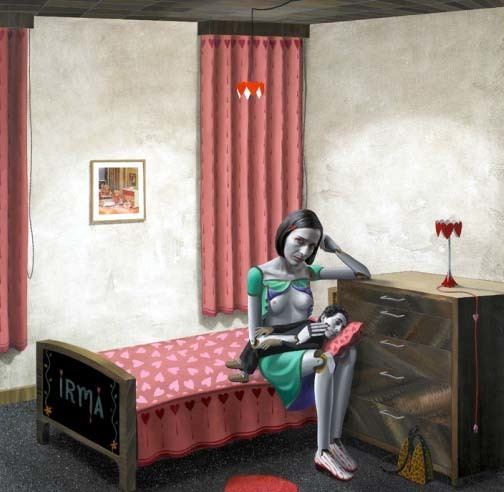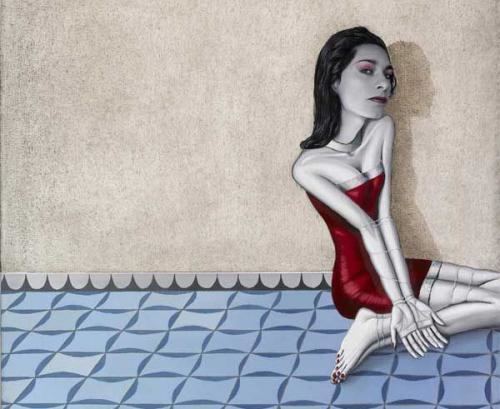Gino Rubert (born in Mexico D.F., 1969) is a Catalan artist. He lives and works in Barcelona, Berlin and Cuernavaca (Mexico). Rubert has worked in the media of painting, video and installation art.

Son of the well-known Catalan philosopher Xavier Rubert de Ventos and the Mexican psychoanalyst and writer Magdalena Catala He studied Illustration at the Parsons School of New York and Fine Arts at the University of Barcelona. In 1993 he won the Sala Pares Young Painting Prize. The same year he was also granted by the Spanish Academy in Rome in recognition of two hyper-realistic paintings.
In 2008, three paintings of his were used to illustrate both Catalan and Spanish covers for Millenium trilogy by Stieg Larsson.
He has taught at several art schools and universities such as Massana and EINA in Barcelona, Centro Cultural de Espana in Montevideo or Universidad Nacional de Bogota.

Rubert is a multidisciplinary artist who works in a wide range of media, such as, painting, drawing, watercolor, video, installation or sculpture. Recently, he has been working on a series of paintings, drawings and little objects called “ex-votos” in reference to the homonymous Mexican devotional offers.
He is mostly known for his particular collage technique combining acrylic painting with photography, holograms, fabric, thread, plastic, human hair and other elements. The use of old and recent photographic portraits, found in marketplaces around the world, downloaded from the Internet or shot and edited by him are ever-present in his works.
Rubert cites the Post-Impressionists and their circle as his main influence, including Henri Rousseau, Bonnard, Gauguin, and Toulouse-Lautrec. Great European Masters like Fra Angelico, Jan Van Eyck and Vermeer also influenced Rubert’s painting. We can also find some references to avant-garde and contemporary artists such as Balthus, David Hockney, Alex Katz or Georg Baselitz. There are also visible parallels with the masters of Latin American Realismo Magico and Surrealismo, including Kahlo, Carrington, and Varo. Rubert’s ideology stems from Spanish painting tradition where images are meant to create the illusion of a different space or dimension.
Rubert’s works have an ironic sense of humor and are charged with a subtle and naif eroticism. Interested in personal and sentimental complexities he explores romance and relationships in contemporary society digging deep into love, sex and couple.
Rubert’s canvases often have different layers of meaning. He describes himself as “a creator of both beautiful and annoying” images that elude/avoid any narrative or lineal interpretation and he says he tries “to make images that suggest something instead of explaining a particular story”.
His works have been exhibited in several museums, galleries and cultural centers worldwide such as the Akioshiday Museum (Japan), Museo Reina Sofia (Madrid), Kunstlerhaus Bethanien (Berlin), Centre de Cultura Contemporania de Barcelona, and Museu Nacional d’Art de Catalunya (Barcelona). He is represented in numerous museums and collections.
In 2011, his first novel, “Apio. Notas Caninas”, was published and awarded New Talent Literature Prize by FNAC.
Grants and Awards
2004, Shuohocho International Exchange House, Japan.2004, Primer Premio a la Videocreacion Latinoamericana, Casa America, Madrid.2003, Mencion Honorifica de Pintura, XXVIII Premio Bancaja de Pintura, Valencia.2002, II Festival de Video, Fundacion Bracara Augusta, Braga, Portugal.2001, Primer Accesito Premi Honda-La Garriga, Spain.1998, XXVI Certamen Nacional de Pintura, Caja Madrid, Madrid.1993, Beca de la Academia Espanola en Roma, Roma.1993, Beca de la Real Academia de San Fernando, Madrid.1993, XXXV Premio de Pintura Joven, Sala Pares, Barcelona.2014, Ex-voto, Galeria Senda, Barcelona.2012, True Love, Claire Oliver Gallery, New York.2010, Galerie Michael Haas, Berlin.2010, Can Sistere Centre d'Art Contemporani, Santa Coloma de Gramenet.2009, Irma lentamente, Galeria Senda, Barcelona.2009, Circulo de lectores, Barcelona.2008, La llico d'anatomia Museu de l'Emporda, Figueres.2008, Spoiled Boy, Artrepco Gallery, Zurich.2007, Spielzimmer, Anita Beckers Gallery, Frankfurt.2007, True Blues, Mizuma Gallery, Tokyo.2006, Morocha, Galeria Senda, Barcelona.2006, Playtime, Museo Gustavo de Maeztu, Estella.2005, De generos. Museo de la Universidad de Alicante, Alacant.2005, Noc Noc. Museu Nacional d'Art de Catalunya, Barcelona.2004, Walks & Heads. Akiyoshidai International Art Village, Yamaguchi.2004, Noc Noc, Palau de la Virreina, Barcelona.2004, Forum 2004 de les Cultures, Barcelona.2003, Delirios Colaterales, Galeria Canem, Castello de la Plana.2003, Femenino Singular, Museo de Arte de la Universidad Nacional, Bogota.2003, Programa del Liceu, Galeria Senda, Barcelona.2003, Centro Cultural de Espana, Miami.2002, La Viuda Alegre, Salon du Printemps, Montreal2002, Notas Caninas, Diario Levante, Valencia.2002, Anunciacio. Nau Coclea, Camallera.2002, Virginia Miller Gallery, Miami.1999, Diario de intramuros, Galeria Senda, Barcelona.1997, Self Defeated Man, David Beitzel Gallery, New York.2015, Bodegones y Vanitas, Galeria N2, Barcelona.2014, Travesias, Reales Atarazanas, Valencia, Spain.2013, Free Style, Palacio Pedreno, Fundacion Cajamurcia, Cartagena, Spain.2013, Olor de Cadaques, Museu de Cadaques, Spain.2012, Uberall und nirgends, Reydan Weiss Collection, Villa Jauss, Oberstdorf, Germany.2011, Eine wunderbare Dekade, Kunstlerhaus Bethanien, Berlin.2011, Dream and reality, Galerie Miro, Prague.2010, Atopia, Centre de Cultura Contemporanea, Barcelona.2009, Lust for Life & Dance of Death, Olbricht Collection, Kunsthalle Krems, Austria.2008, Go For it!, Obricht Collection, Neues Museum Weserburg, Bremen, Germany.2007, Sexe i Rauxa, Museu d’Art Contemporani de Sabadell, Spain.2006, Ironie du Reel, Musee Melik, France.2005, Capturating a Momentito, Young Mexican Artists, Americas Society, New York.2005, Dalimitar, Museu d’Emporda, Figueres, Spain.2004, Depicting Love, MNCARS, Madrid; Centro Parraga, Seville; Kunstlerhaus Bethanien, Berlin.2004, Love Loop, Casa America de Madrid, Madrid.2004, Love is in the air, AECI, Montevideo, Uruguay; Nau Coclea, Camallera, Spain; Sa Nostra, Palma de Mallorca, Spain.2002, Love Loop, II Festival de Video, Fundacion Bracara Augusta, Braga, Portugal .2001, Video en orbita: Cual mujer, Galeria SENDA, Barcelona.2000, Metarrealidad, Sala Pares, Barcelona.Museums and Collections
Antoni Vila Casas Foundation, Barcelona.Banco de Espana Collection, Madrid.Bruno Ragazzi Collection, Milano.Caixa de Pensions de Barcelona Collection, BarcelonaCaja Madrid Collection, Madrid.Castillo Foundation, Spain.Contemporary Art Collection, Pamplona.Delvaux Collection, Brussels.El Monte Foundation, Seville.Fowler Collection, Los Angeles.Fran Daurel Foundation, Barcelona.Giuseppe Castiglioni Collection, Milano.Gregory Fowler Collection, Los Angeles.Honda Collection, Madrid.International Catalonia University Collection, Barcelona.La Caixa Foundation, Barcelona.L’Oreal Collection , Madrid.Martinez Guerricabeitia Collection, Valencia.Olor Visual Collection, Barcelona.San Fernando Academy, Madrid.Scheringa Museum, Spanbroek, Netherlands.Spanish Academy in Rome, Rome.Steinkamp Collection, New York.Thomas Olbrich Collection, Essen, Germany.Van Damme Collection, Amsterdam.


